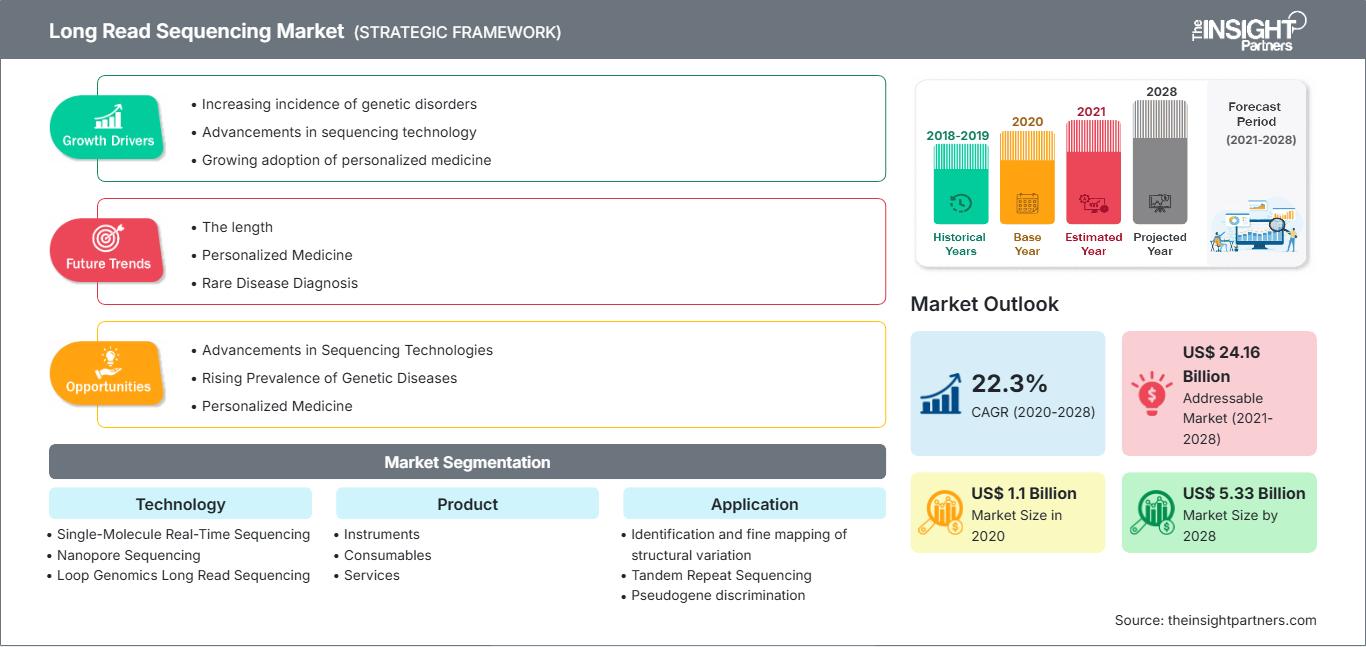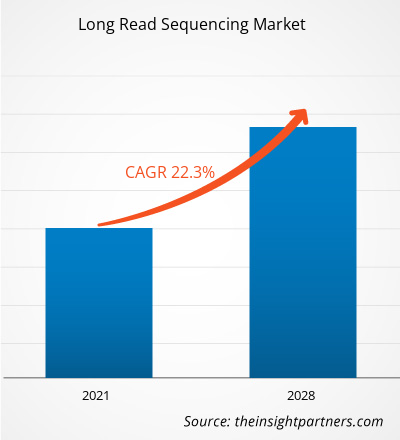Long Read Sequencing Market Key Players and Opportunities by 2028
Historic Data: 2018-2019 | Base Year: 2020 | Forecast Period: 2021-2028Long Read Sequencing Market Forecast to 2028 - COVID-19 Impact and Global Analysis By Technology (Single-Molecule Real-Time Sequencing (SMRT), Nanopore Sequencing, Loop Genomics Long Read Sequencing), Product (Instruments, Consumables, Services), Application (Identification and fine mapping of structural variation, Tandem Repeat Sequencing, Pseudogene discrimination, Resolving allele phasing, Reproductive genomics, Cancer, Viral and Microbial Sequencing, Others), Workflow (Pre-sequencing, Sequencing, Data Analysis), End User (Academic Research Institutes, Hospitals and Clinics, Pharma and Biotechnology Companies) and Geography
- Report Date : Apr 2021
- Report Code : TIPRE00006815
- Category : Life Sciences
- Status : Published
- Available Report Formats :


- No. of Pages : 125
The long read sequencing market was valued at US$ 1,101.15 million in 2020 and it is projected to reach US$ 5,334.68 million by 2028; it is expected to grow at a CAGR of 22.3% during 2021–2028.
The long read sequencing is a DNA sequencing technique. It offers numerous distinct advantages than next-generation sequencing technologies such as more precisely sequence DNA containing the same sections of DNA repeated within the genome. Many adults aged 60 years and above suffer from two or more chronic illnesses. Genes play a role in chronic diseases such as cardiovascular disease, diabetes, obesity, RA, Alzheimer's disease (AD), and depression, according to twin research. According to the Centers for Disease Control and Prevention (CDC), about 6 out of 10 individuals in the US are affected by at least one chronic disease, as well as 4 out of 10 are suffering from two or more chronic diseases. Furthermore, cancer is primarily caused by genomic errors. Researchers have analyzed cancer genomes using a variety of rapidly evolving sequencing technologies in order to better understand cancer cells' molecular status and expose their vulnerabilities such as driver mutations or gene expression. The researchers were able to recognize and classify new forms of cancerous mutations using long-read technologies, including complex structural variants in haplotype resolution. In recent years, several long read sequencing technologies have been developed and used. For example, Pacific Biosciences developed SMRT sequencing, which is one of the long read methods (PacBio). Long read sequencing is becoming more common, and cancer studies based on long read data are growing and advancing in order to decode complex cancer genomes.
Customize This Report To Suit Your Requirement
You will get customization on any report - free of charge - including parts of this report, or country-level analysis, Excel Data pack, as well as avail great offers and discounts for start-ups & universities
Long Read Sequencing Market: Strategic Insights

-
Get Top Key Market Trends of this report.This FREE sample will include data analysis, ranging from market trends to estimates and forecasts.
Market Insights: Advantages of Long Read Sequencing Drives Long Read Sequencing Market
Long-read technologies are overcoming early limitations of accuracy and throughput and mounting their application in the fields of genomics. Long read sequencing or third-generation sequencing offers several advantages over short-read sequencing. While short-read sequencers such as Illumina’s HiSeq, NovaSeq, NextSeq, and MiSeq instruments, BGI’s MGISEQ and BGISEQ models; or Thermo Fisher’s Ion Torrent sequencers produce reads of up to 600 bases, long read sequencing technologies regularly generate reads over 10 kb Further, long reads can improve de novo assembly, mapping certainty, transcript isoform identification, and detection of structural variants. Also, long read sequencing of native molecules, i.e., DNA and RNA eliminates amplification bias while preserving base modifications. With continuing progress in accuracy, throughput, and cost reduction, these capabilities have begun to make long read sequencing an option for a broad range of applications in genomics for model and non-model organisms.
Technology:Insights
The global long read sequencing market, based on technology, is segmented into single-molecule real time sequencing (SMRT), nanopore sequencing, and loop genomics long read sequencing. The single-molecule real time sequencing (SMRT) segment held the largest share of the market in 2020. However, the loop genomics long read sequencing segment is expected to register the highest CAGR in the market during the forecast period.
Product:Based on product, the global long read sequencing market is segmented into instruments, consumables, and services. The instruments segment held the largest share of the market in 2020, and the services segment is expected to register the highest CAGR during 2021–2028.
Application:Based on application, the global long read sequencing market is segmented into identification and fine mapping of structural variation, tandem repeat sequencing, pseudogene discrimination, resolving allele phasing, reproductive genomics, cancer, viral and microbial sequencing, and others. The identification and fine mapping of structural variation segment held the largest share of the market in 2020, and the cancer segment is expected to register the highest CAGR from 2021 to 2028.
Workflow:Based on workflow, the global long read sequencing market is segmented into pre-sequencing, sequencing, and data analysis. The sequencing segment held the largest share of the market in 2020, and the same segment is expected to register the highest CAGR during 2021–2028.
End-User:Based on end-user, the global long read sequencing market is segmented into academic research institutes, hospitals and clinics, and pharma and biotechnology companies. The academic research institutes segment held the largest share of the market in 2020, and the same segment is expected to register the highest CAGR during 2021–2028. Long Read Sequencing Market Regional Insights
The regional trends and factors influencing the Long Read Sequencing Market throughout the forecast period have been thoroughly explained by the analysts at The Insight Partners. This section also discusses Long Read Sequencing Market segments and geography across North America, Europe, Asia Pacific, Middle East and Africa, and South and Central America.
Long Read Sequencing Market Report Scope
| Report Attribute | Details |
|---|---|
| Market size in 2020 | US$ 1.1 Billion |
| Market Size by 2028 | US$ 5.33 Billion |
| Global CAGR (2020 - 2028) | 22.3% |
| Historical Data | 2018-2019 |
| Forecast period | 2021-2028 |
| Segments Covered |
By Technology
|
| Regions and Countries Covered |
North America
|
| Market leaders and key company profiles |
|
Long Read Sequencing Market Players Density: Understanding Its Impact on Business Dynamics
The Long Read Sequencing Market is growing rapidly, driven by increasing end-user demand due to factors such as evolving consumer preferences, technological advancements, and greater awareness of the product's benefits. As demand rises, businesses are expanding their offerings, innovating to meet consumer needs, and capitalizing on emerging trends, which further fuels market growth.

- Get the Long Read Sequencing Market top key players overview
Players operating in the long read sequencing market adopt collaboration and partnership strategies to meet the demands of end users through the introduction of technologically advanced offerings, and these strategies significantly support the growth of the market.
By Technology
- Single-Molecule Real-Time Sequencing (SMRT)
- Nanopore Sequencing
- Loop Genomics Long Read Sequencing
By Product
- Instruments
- Consumables
- Services
By Application
- Identification and Fine Mapping of Structural Variation
- Tandem Repeat Sequencing
- Pseudogene Discrimination
- Resolving Allele Phasing
- Reproductive Genomics
- Cancer
- Viral and Microbial Sequencing
- Others
By Workflow
- Pre-sequencing
- Sequencing
- Data Analysis
By End User
- Academic Research Institutes
- Hospitals and Clinics
- Pharma and Biotechnology Companies
By Geography
-
North America
- US
- Canada
- Mexico
-
Europe
- France
- Germany
- Italy
- UK
- Spain
-
Asia Pacific
- China
- India
- South Korea
- Japan
- Australia
-
Middle East and Africa
- South Africa
- Saudi Arabia
- UAE
-
South and Central America
- Brazil
- Argentina
Company Profiles
- Oxford Nanopore Technologies
- Tataa Biocenter
- Illumina, Inc
- Perkinelmer Inc.
- F. Hoffmann-La Roche Ltd.
- Baseclear B.V.
- Bionano Genomics
- Longas Technologies
- Pacific Biosciences of California, Inc.
- Quantapore, Inc.
Frequently Asked Questions
What are the restraining factors for the long read sequencing market across the globe?
What are the driving factors for the long read sequencing market across the globe?
What are the major companies operated in this market?
Mrinal is a seasoned research analyst with over 8 years of experience in Life Sciences Market Intelligence and Consulting. With a strategic mindset and unwavering commitment to excellence, she has built deep expertise in pharmaceutical forecasting, market opportunity assessment, and developing industry benchmarks. Her work is anchored in delivering actionable insights that empower clients to make informed strategic decisions.
Mrinal’s core strength lies in translating complex quantitative datasets into meaningful business intelligence. Her analytical acumen is instrumental in shaping go-to-market (GTM) strategies and uncovering growth opportunities across the pharmaceutical and medical device sectors. As a trusted consultant, she consistently focuses on streamlining workflow processes and establishing best practices, thereby driving innovation and operational efficiency for her clients.
- Historical Analysis (2 Years), Base Year, Forecast (7 Years) with CAGR
- PEST and SWOT Analysis
- Market Size Value / Volume - Global, Regional, Country
- Industry and Competitive Landscape
- Excel Dataset
Testimonials
The Insight Partners' SCADA System Market report is comprehensive, with valuable insights on current trends and future forecasts. The team was highly professional, responsive, and supportive throughout. We are very satisfied and highly recommend their services.
RAN KEDEM Partner, Reali Technologies LTDsI requested a report on a very specific software market and the team produced the report in a few days. The information was very relevant and well presented. I then requested some changes and additions to the report. The team was again very responsive and I got the final report in less than a week.
JEAN-HERVE JENN Chairman, Future AnalyticaWe worked with The Insight Partners for an important market study and forecast. They gave us clear insights into opportunities and risks, which helped shape our plans. Their research was easy to use and based on solid data. It helped us make smart, confident decisions. We highly recommend them.
PIYUSH NAGPAL Sr. Vice President, High Beam GlobalThe Insight Partners delivered insightful, well-structured market research with strong domain expertise. Their team was professional and responsive throughout. The user-friendly website made accessing industry reports seamless. We highly recommend them for reliable, high-quality research services
YUKIHIKO ADACHI CEO, Deep Blue, LLC.This is the first time I have purchased a market report from The Insight Partners.While I was unsure at first, I visited their web site and felt more comfortable to take the risk and purchase a market report.I am completely satisfied with the quality of the report and customer service. I had several questions and comments with the initial report, but after a couple of dialogs over email with their analyst I believe I have a report that I can use as input to our strategic planning process.Thank you so much for taking the extra time and making this a positive experience.I will definitely recommend your service to others and you will be my first call when we need further market data.
JOHN SUZUKI President and Chief Executive Officer, Board Director, BK TechnologiesI wish to appreciate your support and the professionalism you displayed in the course of attending to my request for information regarding to infectious disease IVD market in Nigeria. I appreciate your patience, your guidance, and the fact that you were willing to offer a discount, which eventually made it possible for us to close a deal. I look forward to engaging The Insight Partners in the future, all thanks to the impression you have created in me as a result of this first encounter.
DR CHIJIOKE ONYIA MANAGING DIRECTOR, PineCrest Healthcare Ltd.Reason to Buy
- Informed Decision-Making
- Understanding Market Dynamics
- Competitive Analysis
- Identifying Emerging Markets
- Customer Insights
- Market Forecasts
- Risk Mitigation
- Boosting Operational Efficiency
- Strategic Planning
- Investment Justification
- Tracking Industry Innovations
- Aligning with Regulatory Trends




















 Get Free Sample For
Get Free Sample For